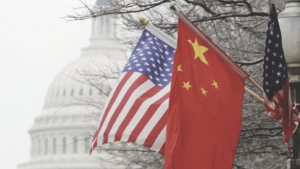April 2/9, 2018: Volume 33, Issue 21
By Ken Ryan
 Flooring executives are acting with trepidation amid the escalating trade dispute between the U.S. and China, which ratcheted up a few notches last week when the Trump administration threatened to impose tariffs on some $50 billion in Chinese imports across 1,300 categories of products.
Flooring executives are acting with trepidation amid the escalating trade dispute between the U.S. and China, which ratcheted up a few notches last week when the Trump administration threatened to impose tariffs on some $50 billion in Chinese imports across 1,300 categories of products.
The imports targeted for 25% levies range from high value-added goods, such as medicines and medical equipment, to intermediate products like machine tools and chemicals as well as durable consumer goods such as dishwashers, TVs and automobile parts. The list also includes machinery used in the production of some flooring products, including carpet and rugs, as well as milling or molding machines for products such as wood, cork, hard rubber, plastics or similar hard materials.
The day after Trump’s announcement, the Chinese Ministry of Commerce announced plans to impose a 25% tariff on $50 billion worth of U.S. exports. The 106 affected products included soybeans and chemicals and came one day after China announced tariffs on $3 billion in imports of U.S. food and other goods, 128 categories in all.
The penalties will not happen right away, if at all. The designation of targeted products will be followed by a comment period in which American companies can provide feedback to the Trump administration on the product choices. The administration will hold a public hearing on the submissions on May 15 in Washington, and companies will have until May 22 to file final objections.
 The move stems from a White House investigation into China’s use of pressure, intimidation and theft to obtain American technologies.
The move stems from a White House investigation into China’s use of pressure, intimidation and theft to obtain American technologies.
Flooring executives argue that in a global economy, any trade war between economic powers would ultimately result in a slowdown of the world economy. Thomas Baert, president of CFL Flooring, a China-based LVT supplier, said issuing large import tariffs sounds like a great idea since theoretically it would help local production in the West but would hurt categories like LVT, which are mostly sourced in China. “In our industry, the product categories that are imported at this stage cannot be made on the domestic machines,” Baert said. “Although several manufacturers are now transforming some production lines to be able to, it is questionable whether this will truly replace China production.”
Don Finkell, CEO of American OEM, a domestic wood manufacturer, had a different take as he pointed to the U.S. trade deficit. “We’re running at an $800 billion trade deficit with the rest of the world, of which $500 billion of that is with China. Most economists say that it is unsustainable, but they don’t really agree on what the consequences are. It’s been this way for more than a decade and growing. Since more jobs are involved in making a product than in importing a product, loss of jobs seems to be the long-term consequence of a trade deficit.”
Finkell said wood flooring going to China from the U.S. has a combination of tariffs, fees and taxes in the range of 27%. If there is a tariff on wood flooring under these trade actions, he said he would expect it to be in the range of 25%. He termed it “significant but not catastrophic to the industry.”
Flooring observers say the tariffs—should they be implemented—would impact the full line distributor to a greater extent than other sectors since wholesalers have been importing LVT/WPC/SPC products in large part to promote their own private-label brands. Jeff Hamar, president of Galleher, a top 20 distributor from Santa Fe Springs, Calif., which sources from China, said he would be very surprised if flooring is ever involved in the tariffs. “There are already duties on wood flooring produced in China so, in theory, the government is already adjusting those prices to reflect market realities,” he said. “If they were to go after rigid LVT flooring the argument would be that there is so little U.S. domestic capacity, who are they harming? Clearly, any duty would be passed onto the consumer and would result in higher prices. Duties on LVT would cut the gap between wood and LVT possibly helping wood flooring sales.”
Jonathan Train, CEO of Houston-based Swiff-Train Co., which also sources extensively from Asia, is clearly not an advocate for excessive tariffs. “Small tariffs that are clearly understood and fairly implemented are fine and do not block trade,” he said. “Plus, they add a reasonable means of revenue for the government. But larger, volatile and retroactive tariffs disrupt markets unnecessarily and do not fix anything.”
Many economists see a trade war as little more than punishing the other country rather than protecting domestic producers. Some flooring executives have similar views. “Unfortunately, it’s going to be a ‘tit for tat’ kind of game that we can’t afford to play,” said Olga Robertson, president of the FCA Network. “Imagine just for one second if Walmart couldn’t fill their stores with goods—it would be Armageddon.”
manufacturing to make more stuff here in the U.S.,” said Olga Robertson, president of the FCA Network, Shorewood, Ill. “But unfortunately, it’s going to be a ‘tit for tat’ kind of game that we can’t afford to play. Imagine just for one second if Walmart couldn’t fill their stores with goods—it would be Armageddon.”
